Dutch Snacks: What They Are + How To Order Them (In Dutch)
 Written byFergus O'Sullivan
Written byFergus O'Sullivan- Read time10 mins
- Comments0
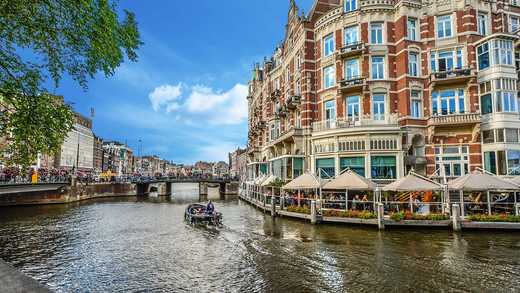
Dutch cuisine isn’t exactly known the world over. There’s a lot of meat and a lot of potatoes; it’s filling, but fairly simple.
However, there is one aspect of Dutch food that isn’t discussed enough: the snacks.
In this article, I’ll go over what Dutch snacks are, the different varieties as well as how to order them.
It’s time to set your Dutch course aside and practice some real-world Dutch.
What are Dutch snacks?
For the purposes of this guide, Dutch snacks are fried goodies, usually bought from the snackbar (pronounced in Dutch as “snek bar”).
Snacks start with chips or french fries, called patat or, in the south of the country, friet (just one of the many differences between Dutch and Flemish).
Fries are usually served with mayonnaise, which most visitors find rather weird until they realize it’s delicious.
Besides fried spuds, you can also expect a wide range of what are called “snacks,” usually breaded and almost exclusively fried goodies.
Most snacks are meat-based, but there are some aimed at vegetarians — though whether they’re suitable is another question.
Some snackbars also have salads, but they’re usually also quite fatty, with lots of mayo and meaty stuff.
As you can imagine, these snacks aren’t exactly health food and your cholesterol levels will skyrocket if you eat them every day.
They’re really more something you eat while on a night out, or if you just can’t be bothered cooking and are craving something that will stick to your ribs — in slang Dutch we call it een vette bek halen - “to grab a fat mouth.”
Different kinds of Dutch snacks
There are a lot of different kinds of snacks: it seems every region has its own idea of what makes for the perfect food for a night out.
However, there are a few staples you can find in any snackbar across the land, as well as northern Belgium.
Let’s take a look at what you can expect.
Fries — Patat en Friet
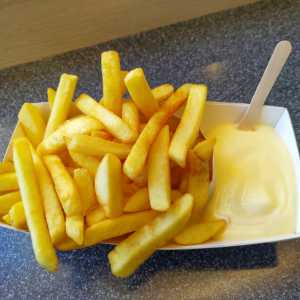
First and foremost are chips — called patat in the northern Netherlands and friet everywhere else.
Though Belgium is the country that’s most associated with fries, they’re just as popular in the Netherlands; there seems to be a place you can buy them on almost every corner.
If you go to a snackbar, chips will usually be served in a flat little box made of plastic, though cardboard is becoming more common now.
However, if you go to a small roadside place — usually just an open storefront — you’ll get them in a pointed bag, or puntzak.
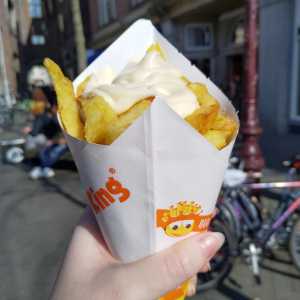
This style is more “traditional,” and places that serve them this way will usually advertise their chips as Vlaamse friet (“Flemish fries”), even in Belgium.
Note that it’s rare for you to get a choice on whether you get a box or a bag, the establishment you’re in serves them the way it serves them, you generally don’t get a say.
The standard way to serve fries is with mayonnaise, though there are plenty of other sauces to choose from, something we’ll get into later.
Kroketten
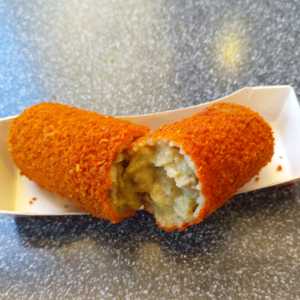
Probably the most popular snack is the kroket, a short-ish tube with a tasty inside wrapped in a breaded exterior.
The standard version has a beef filling, but there are many others to choose from.
Most places will also offer veal (like the above example), but I’ve seen ones with a sateh filling (peanut sauce and pork), ham and cheese, shrimp and countless others.
Other snacks
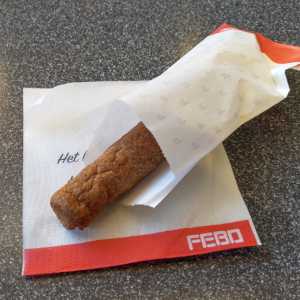
The kroket is probably the most common snack, but there are plenty of others to choose from.
Another staple is the frikandel, a sausage-like fried snack made of — well, nobody knows for sure and the general understanding is that it’s best not to ask.
They’re usually served plain, like above, but you’re best off ordering them with a sauce as they can be a bit dry.
The best thing seems to be ordering them speciaal, which means with mayo, ketchup and raw onions.
Almost all snackbars will offer kroketten and frikandellen, but most will offer other specialties as well.
These include burgers — though these are usually a lot simpler than in other countries, just meat, sauce and a pickle in a small bun — or different varieties of fried meatballs.
You can even get breaded and fried noodles or rice! The bamibal (noodles) and nasischijf (rice) are pretty tasty, but the mix of flavors can take some getting used to, truth be told.
Vegetarians are also catered for: the standard meatless snack is the kaassouffle (cheese souffle), though recently more options have become available.
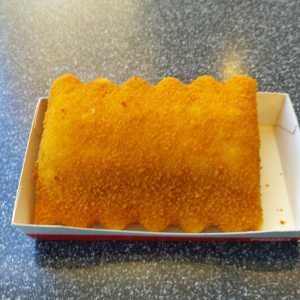
This is a good thing as the kaassouffle can be a bit dry — I’m not a fan, myself.
Now that you have an idea of what’s on offer, let’s see how you can order all these delicious snacks.
De Automatiek
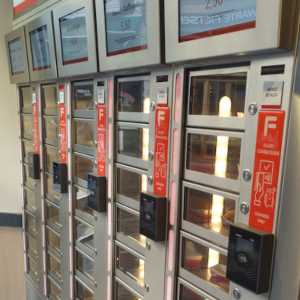
Before we get to the how of ordering, we have some good news for the introverts among you: you can, in some cases, order Dutch snacks without speaking.
Some snackbars, especially busy ones, will have something called an automatiek, an automated machine that lets you buy snacks without interacting with staff.
An automatiek is a set of little doors placed in the wall, with each column offering a specific snack.
Snacks are kept warm through a small heating lamp.
You put money into the slot and then you open the door to grab the snack within. In Dutch it’s called pulling something out of the wall, iets uit de muur trekken.
All you need to do is make sure you use exact change as the machine can’t give money back, though more and more often nowadays you can also pay by card.
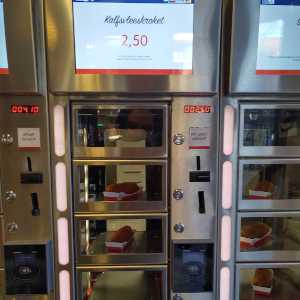
It’s a pretty convenient system that lets you bypass the snackbar counter, though it’s only good for snacks.
It’s extremely rare to see fries sold in the automatiek, and for a reason: they taste terrible.
Never, ever buy fries from the wall.
Kroketten and such survive a lot longer, though you may want to avoid places that don’t change snacks out regularly; after about thirty minutes they usually go a little stale.
Ordering Dutch snacks
However, as with most food, fresh is best, so let’s take a look at how you order fries and snacks in a Dutch or Belgian snackbar.
Note that in all examples we’ll use informal Dutch as you don’t need to be formal in snack bars.
Ordering patat
Let’s start with fries.
We’ll be using the word patat and patatje in these examples, but you can just replace it with friet if you’re in the southern Netherlands or Belgium.
To order fries with mayonnaise is the easiest, you just say:

Een patatje met…, alsjeblieft.
As mayo is considered standard, you don’t have to specify it.
In fact, to make sure you get no sauce, you have to order patatje zonder (fries without).
As most snackbars only have one size of fries, you don’t need to say a size.
However, places that serve in a puntzak often do have different sizes.
These can range a little, but usually go by small, medium, large, or klein, middel, groot.
For example, you can order twee kleine patat zonder and get two small bags without sauce.
Note, though, many places try to be cute and have different ways of naming these.
Instead of large they’ll say reus (giant) or instead of small they’ll say voor de kindertjes (for the children).
You’ll have to figure it out a bit, but usually stubbornly calling them klein or groot or whatever will work.
Fries and sauce
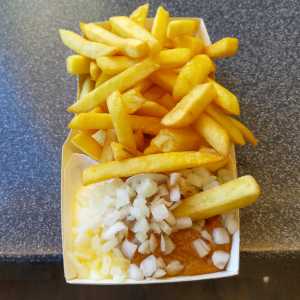
Besides mayo, there are some other sauces to choose from.
The usual choices are ketchup, a spicy version of ketchup called curry (nothing to do with the Indian herb) and peanut sauce (pindasaus or satesaus), which is an originally Indonesian sauce and is simply delicious on fries.
Ketchup and peanut sauce can also be combined with mayo: mayo and ketchup or curry together are speciaal, while peanut sauce and mayo together are called oorlog (which means “war”).
Speciaal and oorlog are usually served with some raw onion, though usually you’ll be asked “uitjes?” (onions?) by the counter worker before serving.
Just answer: ja, graag if you want them, or nee, dank je if you don’t.
If you want to make sure you don’t get any onions, just order een patatje oorlog zonder uien, alsjeblieft and all should be well.
Note that above the rivers — something we go into in our article on Dutch dialects — speciaal is always with ketchup and below it’s always with curry.
If you want the other one, you need to specify it.
So if you’re in Amsterdam, you have to order een patatje speciaal met curry to make sure you don’t get ketchup.
Below you can find a small table with all common sauce options.
| Dutch | English |
|---|---|
| Patatje met | Fries with mayo |
| Patatje zonder | Fries without sauce |
| Patatje ketchup | Fries with ketchup |
| Patatje pinda | Fries with peanut sauce |
| Patatje speciaal | Fries with mayo, ketchup/curry and onions |
| Patatje oorlog | Fries with mayo, peanut sauce and onions |
| Met/zonder uien | With/without onions |
Ordering snacks
Patat is just one side of the equation, of course: you’ll also want a snack or two to go with them.
Ordering snacks is easy, just say what you want and add “please,” so een kroket, alsjeblieft or een frikandel, graag.
However, there are a few extra things you should know: for one, there are a lot of different styles of kroket. If you don’t specify one, you get a beef filling, or rundvleeskroket.
If you prefer veal, you need to ask for a kalfsvleeskroket or, more simply, a kalfskroket.
Chances are, your snackbar offers other kinds, too.
You just need to either check the menu or, if there isn’t one, ask the staff wat voor kroketten heb je?
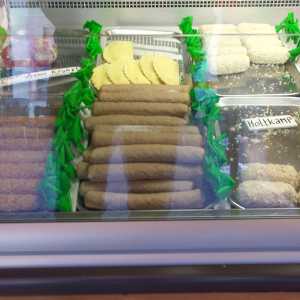
Most snacks can also be put on bread.
It may seem a bit weird at first, but it’s a great way to make a snack more filling, and it’s surprisingly delicious.
To order one, you just order the word broodje (literally “little bread”) to the order, so broodje kroket, broodje frikandel, etc.
In fact, if you’re in a sandwich bar, you can order anything that way, so a cheese sandwich is broodje kaas, a ham sandwich is broodje ham, the list goes on.
Putting it all together
Now that you know a little more about snacks and how to order them, let’s put together a few examples.
Say you want two fries with peanut sauce and mayo, but one without onions, as well as a frikandel with mayo and curry sauce, plus a kroket sandwich — not an unusual order.
That would look something like this:

Twee patatjes oorlog graag, één zonder uitjes, een frikandel speciaal met curry en een broodje kroket, alsjeblieft.
In most cases the staff will get right to work on this, though they may check about onions on the frikandel by asking something like frikandel ook met uitjes?
Another good example is just a large fries order, without snacks, say for a group of people after your Dutch class.
If you want two fries with may, one fries without sauce, two with peanut sauce and one speciaal, it could end up like this:

Twee patat met, één zonder, twee met pinda en eentje speciaal.
The staff will check if you want the speciaal with ketchup or curry and whether it’s with onions, but other than that you should be set for six orders of chips.
Hopefully this guide will have gotten you confident enough to head over to your local snackbar right now and practice your newfound knowledge.
Have fun and enjoy your Dutch snacks.
Eet smakelijk!
🎓 Cite article
 Grab the link to this article
Grab the link to this article
Let me help you learn Dutch
JOIN THE GUILD:

Donovan Nagel - B. Th, MA AppLing
I'm an Applied Linguistics graduate, teacher and translator with a passion for language learning (especially Arabic).

















 Arabic Resources
Arabic Resources Spanish Resources
Spanish Resources French Resources
French Resources Italian Resources
Italian Resources German Resources
German Resources Mandarin Chinese Resources
Mandarin Chinese Resources Hindi Resources
Hindi Resources Portuguese Resources
Portuguese Resources Korean Resources
Korean Resources Japanese Resources
Japanese Resources Russian Resources
Russian Resources








COMMENTS
NO ADVERTISING. Links will be automatically flagged for moderation.